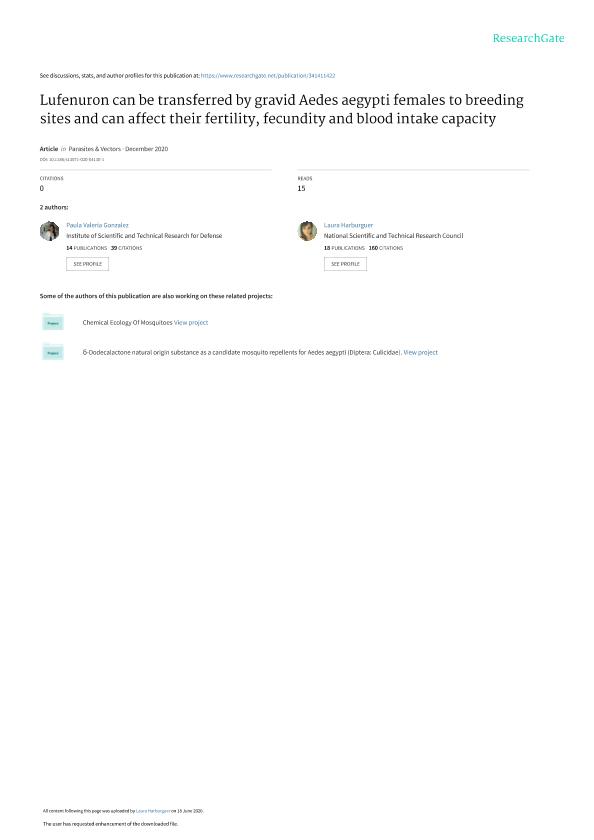Mostrar el registro sencillo del ítem
dc.contributor.author
Gonzalez, Paula Valeria

dc.contributor.author
Harburguer, Laura Vanesa

dc.date.available
2021-10-25T19:40:41Z
dc.date.issued
2020-05-15
dc.identifier.citation
Gonzalez, Paula Valeria; Harburguer, Laura Vanesa; Lufenuron can be transferred by gravid Aedes aegypti females to breeding sites and can afect their fertility, fecundity and blood intake capacity; BioMed Central; Parasites and Vectors; 13; 257 ; 15-5-2020; 1-8
dc.identifier.issn
1756-3305
dc.identifier.uri
http://hdl.handle.net/11336/144996
dc.description.abstract
BACKGROUND: Aedes aegypti (L.) is the main vector of dengue, yellow fever, Zika and chikungunya viruses. A new method for controlling this mosquito has been developed based on the possibility that wild adult mosquitoes exposed to artificial resting sites contaminated with a larvicide, can disseminate it to larval breeding sites, is named "auto-dissemination". The present study was undertaken to evaluate if a chitin synthesis inhibitor like lufenuron can be disseminated to larval breeding sites and prevent adult emergence and also if forced contact of Ae. aegypti females with treated surfaces can affect its fertility, fecundity, and blood intake capacity. METHODS: Larval susceptibility to lufenuron was measured through EI50 and EI90. On the other hand, gravid females were exposed by tarsal contact to lufenuron-treated papers, we used the WHO susceptibility test kit tube to line the papers, and 1, 3 or 5 females for the transference. We also evaluated if the exposure of female mosquitoes to lufenuron-treated papers (0.4 and 1 mg a.i./cm2) has an effect on their fertility, fecundity or in the ability to feed on blood. In each assay 12-15 female mosquitoes were exposed to lufenuron for 1 h, 24 h before blood meal (BBM) or 24 h after a blood meal (ABM). RESULTS: Lufenuron proved to be very active against Ae. aegypti larvae with an EI50 of 0.164 ppb and EI90 of 0.81 ppb. We also found that lufenuron can be transferred by females from treated surfaces to clean containers causing the inhibition of emergence of the larvae (between 30 and 50%). This effect was dependent on the concentration applied on the paper and the number of females added to each cage. CONCLUSIONS: This study introduces an innovation by first exploring the possibility that an insect growth regulator (IGR) belonging to the group of benzoylphenyl ureas, such as lufenuron, can be transferred by gravid females to breeding sites and that at the same time can have an effect on fertility, fecundity and blood intake capacity of adult mosquitoes.
dc.format
application/pdf
dc.language.iso
eng
dc.publisher
BioMed Central

dc.rights
info:eu-repo/semantics/openAccess
dc.rights.uri
https://creativecommons.org/licenses/by-nc-sa/2.5/ar/
dc.subject
AEDES AEGYPTI
dc.subject
AUTO-DISEMINATION
dc.subject
FECUNDITY
dc.subject
FERTILITY
dc.subject
LUFENURON
dc.subject.classification
Zoología, Ornitología, Entomología, Etología

dc.subject.classification
Ciencias Biológicas

dc.subject.classification
CIENCIAS NATURALES Y EXACTAS

dc.title
Lufenuron can be transferred by gravid Aedes aegypti females to breeding sites and can afect their fertility, fecundity and blood intake capacity
dc.type
info:eu-repo/semantics/article
dc.type
info:ar-repo/semantics/artículo
dc.type
info:eu-repo/semantics/publishedVersion
dc.date.updated
2021-09-07T20:01:35Z
dc.journal.volume
13
dc.journal.number
257
dc.journal.pagination
1-8
dc.journal.pais
Reino Unido

dc.journal.ciudad
Londres
dc.description.fil
Fil: Gonzalez, Paula Valeria. Consejo Nacional de Investigaciones Científicas y Técnicas. Unidad de Investigación y Desarrollo Estratégico para la Defensa. Ministerio de Defensa. Unidad de Investigación y Desarrollo Estratégico para la Defensa; Argentina
dc.description.fil
Fil: Harburguer, Laura Vanesa. Consejo Nacional de Investigaciones Científicas y Técnicas. Unidad de Investigación y Desarrollo Estratégico para la Defensa. Ministerio de Defensa. Unidad de Investigación y Desarrollo Estratégico para la Defensa; Argentina
dc.journal.title
Parasites and Vectors

dc.relation.alternativeid
info:eu-repo/semantics/altIdentifier/doi/http://dx.doi.org/10.1186/s13071-020-04130-1
dc.relation.alternativeid
info:eu-repo/semantics/altIdentifier/url/https://parasitesandvectors.biomedcentral.com/articles/10.1186/s13071-020-04130-1
Archivos asociados
